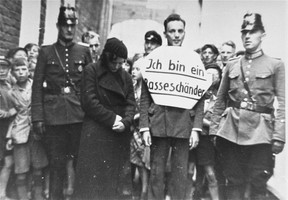KINSELLA: Public humiliation a familiar tactic for antisemites

Article content
“It is not the pain and the wounds that are the worst,” the Swiss philosopher Pascal Mercier wrote, many years ago. “The worst is the humiliation.”
The Nazis knew that. After Adolf Hitler was appointed chancellor of Germany in January 1933, widespread public humiliation of Jews commenced. In one notorious case, a young Jewish man named Julius Wolff and his non-Jewish fiancee, Christine Neeman, were taken by the Nazis’ brown shirts — the Sturmabteilung — in Norden, Germany, and forced to parade through the streets wearing signs.
Wolff’s said: “Ich bin ein Rasseschänder” — that is, “I am a race defiler.” Wolff and Neeman were later taken to concentration camps.

For the Nazis, public humiliation of Jews, and those who would consort with Jews, wasn’t something that just happened by chance. It was something that was central to their program of oppression of the Jews and non-Aryans, from the very start. It was all designed to inflict suffering on Jews.
But — and this is key — it was also how the Nazis drew a distinction between Jews and non-Jews. Ritual public humiliations were a way to remind ordinary Germans that Jews were not human — they were, as the Nazi propaganda of the time repeatedly proclaimed, parasites. They were vermin, ungeziefer, infecting the corpus of the Third Reich and the world.
We don’t know what the man who assaulted a Jew in a Montreal park a few days ago was thinking, at this point. We likely never will — his defence lawyers will be working overtime to ensure that the judge, or the jury, never hears a solitary word about antisemitism.
So, we will be left to wonder: Was it an argument that simply escalated? A case of mistaken identity? Just an unstable person, assaulting a man in broad daylight, in front of his children?
We still don’t know. But there is the video footage, which has now been seen by many people around the world — and, we are told, was shot by a Muslim woman who was appalled by what she was seeing. The video starts with the victim, a 32-year-old father, on the ground at Dickie-Moore Park in Montreal, being punched and kneed by a man. Montreal Gazette reporter Jesse Feth describes the scene:
“In the video, the suspect can be seen repeatedly punching the victim while he is on the ground. A little girl can be heard yelling as she stands beside and then clings to the victim, who manages to make it back on his knees and eventually stands. The video ends with the suspect walking away and throwing what appears to be a kippah on the wet ground near a fountain … The victim was hospitalized following the attack and suffered a broken nose.”
It’s that last bit — the kippah, the head covering worn by observant Jewish men, to show reverence to God — that is the tell, perhaps. Beating a man in front of his child, humiliating him, is of course bad enough. But why pick up the kippah, a religious symbol, and fling it into the muddy water? Why do that? That is what an antisemite, a Nazi, would do.
A man has now been arrested, and the Montreal police have not deigned to provide us with his name. He will likely be charged with something — assault, and perhaps a hate crime — and he will have his day in court. Days later, some remain shocked by what happened, but some shrug. Prime Minister Mark Carney, for example, posted something about his cat on the day the video emerged — and only condemned the attack in an X post the next day.
What about that father? What about that child? Will they ever forget the humiliation of that moment? Will they be able to look past the ignominy and degradation of that day? Will we ever know why the man in the footage allegedly did such a terrible thing? Why, why?
The answers may lay in the past. Many years ago, a British journalist asked the Treblinka death camp commandant Franz Stangl why the Nazis humiliated their victims. Said the journalist: “Why, if they (the Nazis) were going to kill them (the victims) anyway, what was the point of all the humiliation, why the cruelty?”
Stangl said: “To condition those who actually had to carry out the policies.
“To make it possible for them to do what they did.”














Postmedia is committed to maintaining a lively but civil forum for discussion. Please keep comments relevant and respectful. Comments may take up to an hour to appear on the site. You will receive an email if there is a reply to your comment, an update to a thread you follow or if a user you follow comments. Visit our Community Guidelines for more information.